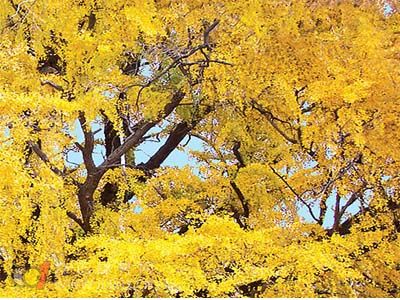Ginkgo tree transplanting attention essentials: Selection of ginkgo seedlings requires strong seedlings, developed roots, white xylem, reddish root bark, closely attached to the xylem. If the roots turn black, even if the trunk is green, it may have already died. Ginkgo trees should be used as the street trees. The trunks are straight, the trees are in the same shape, and the branches are in the seedlings of about 3 meters.
Ginkgo biloba planting is easy to survive before germination in early spring. The soil should be soiled with rich and fertile soil, organic matter content of 1% to 3%, and good permeability and permeability. Add the decomposed organic fertilizer to the bottom of the pit and add 20 cm of the cooked soil to mix thoroughly to avoid burning the roots. If the weather is dry, fill the planting pit with water and allow the water to seep and then plant. Ginkgo is usually planted with soil balls. Ginkgo is not easy to root after deep burial, so it should be shallow, usually the root line of the original seedling is level with the ground or 1 cm to 2 cm higher.

Ginkgo tree water and fertilizer management is watered from 5 days to 7 days after loading. After the ginkgo is alive, there is no need to irrigate the water. Generally, the first time the water is poured before the germination of the soil. In May, if the weather is dry, you can pour the second water to facilitate the growth and development of ginkgo. During the rainy season, water can be watered depending on the weather. Ginkgo is resistant to drought and fear of phlegm. Because the roots of Ginkgo biloba have a large amount of respiration, it is necessary to prevent roots from rot and death due to excessive moisture in the soil. Fertilization in the spring and autumn, in the periphery of the canopy, using a circular fertilization method or hole-piercing method, apply a decomposed organic fertilizer, watering after application. Ginkgo has fake and suspended animation. Some ginkgo even if the roots are dead, the leaves can spread, and even in the second and third years, the leaves are small. When the nutrients in the tree are exhausted, it does not leave leaves. This is the phenomenon of false living of ginkgo. Some ginkgo plants do not germinate in the first year after planting, and even do not germinate in the second year, but the bark is still bright green, and it is only in the third year that it begins to germinate and spread leaves. This is the phenomenon of fake death of ginkgo. Therefore, some people say: Ginkgo trees are planted for three years, and it is not alive for three years.
Ginkgo tree pruning and pest control Ginkgo biloba does not require special pruning. It can be cut and trimmed before transplanting, and cut off dense branches, diseased branches, wound branches and dead branches. During its growth, due to slow growth, it is generally not trimmed. In the process of conservation, it is necessary to cultivate alfalfa in time to reduce weeds, which is conducive to tree growth, while improving soil aeration conditions, promoting root growth and germination of new roots. Ginkgo biloba has few pests and diseases. In the years of high temperature and drought in summer, when the seedlings are newly planted or newly transplanted, the base of the stem is easily burned and the bacteria invade, and rot is prone to occur after rain. In the summer, a shade shelter or a Bordeaux mixture can be used. The pests are mainly cockroaches. Ginkgo biloba is simple to cultivate and has extensive management. It is an excellent greening tree species. The management of ginkgo tree after transplanting is very important, but the porosity of the soil and the ratio of root size to leaf and leaf retention during transplanting can also affect the survival of ginkgo transplanting.
| Product name | Railway tie plate/ Base plate |
| Type | casting |
| Raw material | QT400-15, QT450-10, QT500-7, ZG25, ZG35, ZG45 |
| Surface | PLAIN (oil), |
| Package | bundle up or packing according to customers' requirement |
Zhongbo Railway Fastening Company is a leading Chinese manufacturer of rail fastening and rail Joint Bar.
Zhongbo, as a specialized rail fastener manufacturer, provides a complete line of products, including rail fastening, anchor, rail joint, rail clip, rail screw, anchor bolt, Rail Clamp plate, rail fishplate, and fishplate bolt for connecting rail tracks.
We also make rail fastenings for crane rail and elevator guide rail, along with other related products. We manufacture according to GB/TB (Chinese national standards and railway standards), AREA, UIC, BS, DIN, ASTM, and AS standards.
Our products are mainly made through hot forging.
The threads of rail screw spikes are made by hot rolling with special threading machines.
We produce metric threads, BS, BSW, TR thread, or round threads.
Spring Blade,Nabla Clip,Elastic Tension Nabla Clip,Nabla Clamp
TAICANG ZHONGBO RAILWAY FASTENING CO., LTD. , https://www.railfastener.com